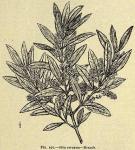 The oil expressed from the ripe fruit of O'lea europae'a Linné.
The oil expressed from the ripe fruit of O'lea europae'a Linné.
BOTANICAL CHARACTERISTICS.—A small evergreen with hard wood. Leaves short-petiolate, opposite, ovate-lanceolate, mucronate. Flowers white, in axillary clusters. Fruit a drupe, ½ to 1 in. long, ovoid, purple, sarcocarp firm, fleshy, filled with oil.
HABITAT.—Levant and the Mediterranean Basin and California.
DESCRIPTION OF OIL.—A pale yellow or greenish-yellow, unctuous liquid when pure, having a bland, sweetish taste, but scarcely any odor. Specific gravity 0.915 to 0.918 at 15°C. (59°F.). On exposure it absorbs oxygen and becomes thick and rancid and loses its color, but does not dry as does linseed oil.
The oil is obtained by crushing the ripe fruit and subjecting the pulp to strong pressure. The expressed oil is run into water and the floating oil is skimmed after a few days' subsidence (virgin oil); the expressed cake is now broken up, mixed with hot water, and again subjected to pressure, resulting in a second-grade oil. The remaining marc yields by solvents, such as carbon disulphide, or by a third expression after fermentation, a very inferior oil.
The oil is adulterated sometimes with cotton-seed oil chiefly, with oil of benne, and with peanut oil.
Preparations: Emplastrum plumbi, Unguentum diachylon.
Sapo, soap, is employed in: Linimentum saponis.
From the olive is obtained the wood so famous for its capability of receiving a fine polish; used in cabinet work of various kinds. The unripe fruit is served at the table. It is prepared by repeatedly steeping it in water containing lime and ashes, then bottling in a slightly aromatic salt solution; the small French or Provence, the finest, and the large Spanish are both used for this purpose.
CONSTITUENTS.—At about 5°C. (41°F.) white crystalline granules separate out, which consist of palmitin with possibly some stearin and arachin. The liquid portion remaining consists almost entirely of olein, C3H5(OC18H33O)3, which forms about 72 per cent. of the oil. The green color is due to chlorophyll.
ACTIONS AND USES.—Nutritive and laxative, a common ingredient in laxative enemata; externally protective and emollient. Its chief use in pharmacy is in liniments, cerates, and plasters. Dose: 1 fl. Oz. (30 mils).

